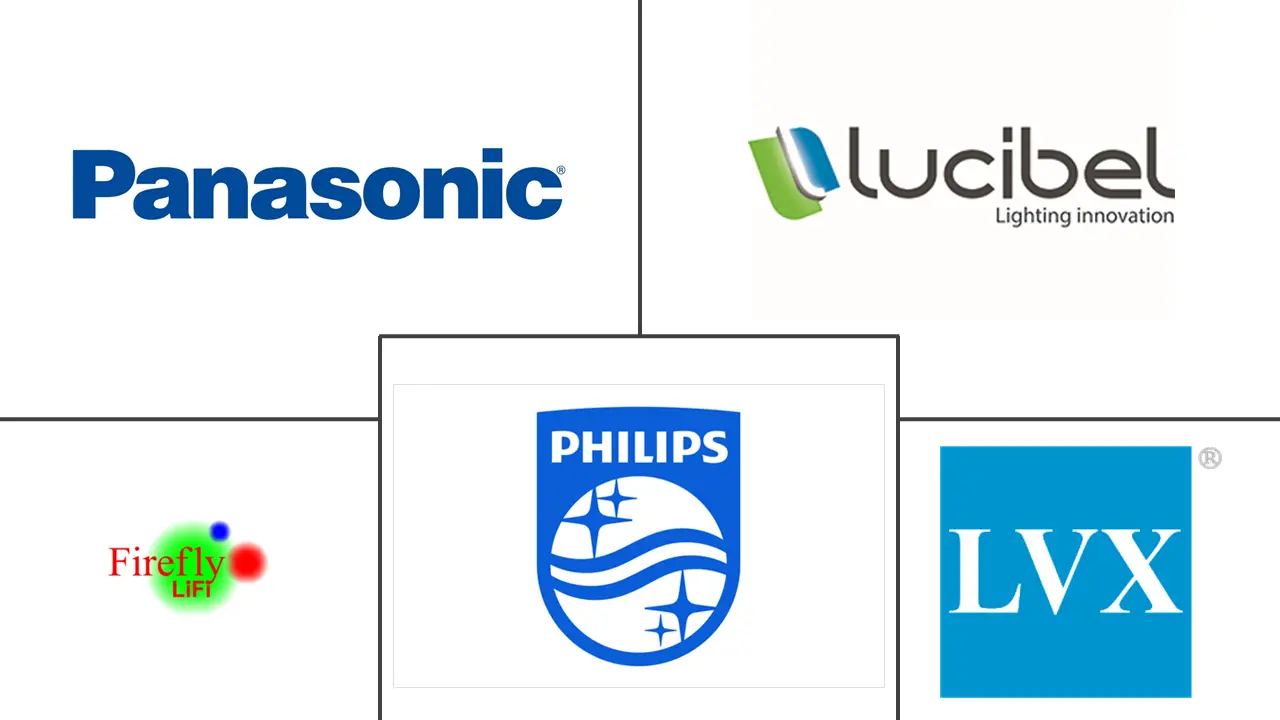Visible Light Communication Market Size and Share
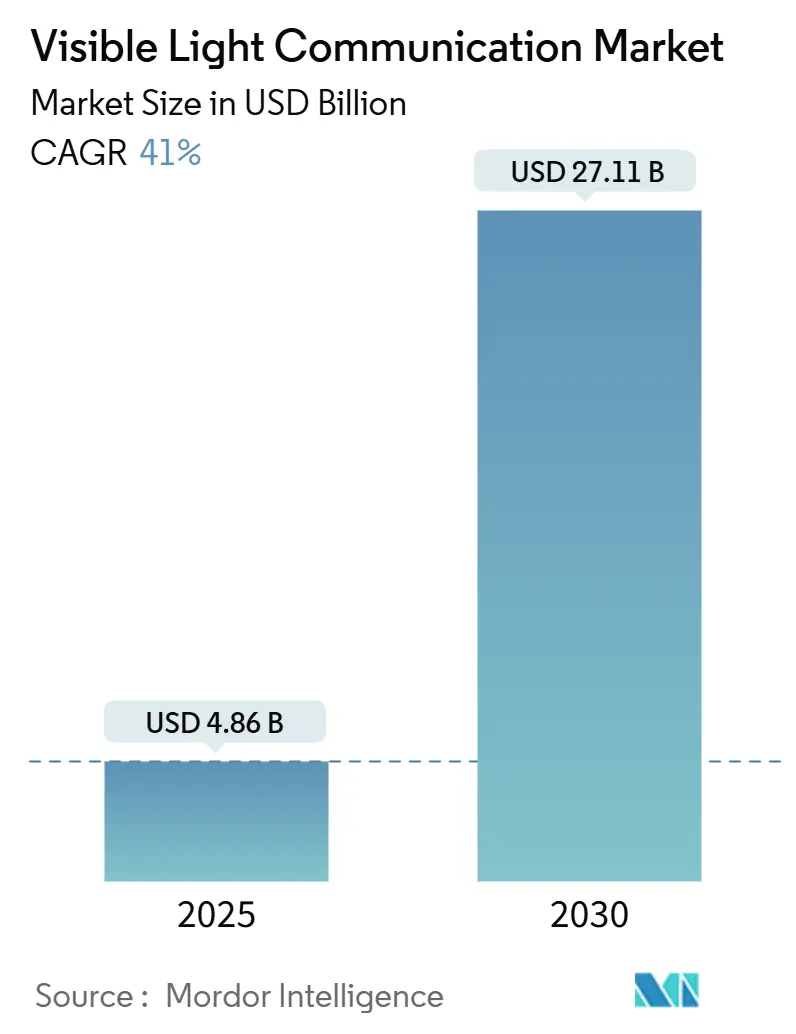
Visible Light Communication Market Analysis by Mordor Intelligence
The Visible Light Communication Market size is estimated at USD 4.86 billion in 2025, and is expected to reach USD 27.11 billion by 2030, at a CAGR of 41% during the forecast period (2025-2030).
- Visible light communication (VLC) is witnessing a surge in popularity, thanks to its distinct advantages and the ever-evolving tech landscape. A standout feature of VLC is its built-in security: light signals can't penetrate walls, bolstering data privacy. On top of that, VLC outpaces traditional wireless technologies, like Wi-Fi, in speed. With the capability to transmit data at rates reaching several gigabits per second, VLC is revolutionizing fields that demand high bandwidth, such as gaming, video streaming, and extensive data transfers.
- In settings like hospitals and aircraft cabins, where radio frequency emissions can be problematic, VLC emerges as a strong alternative, especially amidst rising concerns about electromagnetic interference. The market for visible light communication (VLC) is primarily fueled by the demand for rapid data transfer, heightened data security, and the myriad technological benefits it boasts over conventional Wi-Fi.
- Additionally, the prevalent use of energy-efficient LED lighting lays a solid groundwork for embedding VLC capabilities, allowing for communication without major overhauls to current infrastructures. As VLC technology matures and navigates challenges like scalability and interoperability, its uptake is set to rise in diverse applications, from indoor positioning and Li-Fi internet access to advanced smart lighting systems.
- VLC stands out for Internet of Things (IoT) devices, ensuring dependable and secure communication, especially in settings where traditional wireless methods like Wi-Fi or Bluetooth might face interference. Beyond its cost-effectiveness, VLC boasts advantages over standard Wi-Fi, such as data transfer speeds nearly 100 times faster, enhanced data security, resilience against electromagnetic interference, and reduced power consumption.
- Market players are actively launching products and innovating to meet the dynamic needs of consumers. For instance, in October 2024, Nav Wireless Technologies Pvt Ltd, hailing from Ahmedabad and a frontrunner in LiFi technology, unveiled a suite of cutting-edge products at the upcoming India Mobile Congress (IMC) 2024. These advanced offerings, tailored for the BharatNet Phase 3 Project, have garnered the green light from the Department of Telecommunications (DoT) for LiFi deployment, especially in locales where traditional radio and fiber solutions fall short.
- Yet, for VLC to achieve widespread acceptance, it must navigate several hurdles. Its range, when juxtaposed with radio frequency (RF), can limit its application in certain scenarios. Furthermore, VLC demands a direct line-of-sight between its transmitter and receiver, narrowing its potential uses. Environmental light sources, such as sunlight and fluorescent lights, can disrupt VLC signals. These challenges could hinder the market's growth trajectory.
Global Visible Light Communication Market Trends and Insights
The Consumer Electronics Segment is Anticipated to Witness a Significant Market Growth
- Consumer electronics are increasingly turning to Visible Light Communication (VLC) for its promise of high-speed data transfer, enhanced security, and minimal electromagnetic interference. VLC operates by using visible light to transmit data, offering a secure and interference-free alternative to traditional radio frequency (RF)-based communication systems. This unique trait of VLC, which ensures it doesn't disrupt RF-based devices, positions it as a prime choice for sensitive environments like hospitals, where medical equipment must remain unaffected, and industrial settings, where electromagnetic interference can disrupt operations. Additionally, VLC's ability to function in environments with high RF congestion further enhances its appeal in these applications.
- Smartphones harness visible light communication (VLC) technology, enabling data transmission via their screens and cameras. Beyond this, VLC fosters wireless connections among devices—be it smartphones, laptops, or tablets—streamlining the transfer of data like photos, music, and videos. When receiving data, a smartphone decodes information from another device's screen, leveraging algorithms such as Speeded Up Robust Features (SURF) for extraction and identification. This technology ensures efficient and secure data transfer, making it a reliable option for various applications.
- According to Ericsson, global smartphone subscriptions are anticipated to reach 8,330 million by 2030, from 6,930 million in 2023. This growth reflects the increasing penetration of mobile devices worldwide, driven by technological advancements and affordability. With 5G on track to dominate mobile access subscriptions, this surge is set to amplify the demand for consumer electronics, propelling the growth of the market in focus, which further supports the expansion of the VLC market.
- As the appetite for high-speed data transmission surges—especially for video streaming and gaming—VLC emerges as a compelling alternative to conventional wired and wireless communication methods. It delivers swift data transfer without the need for physical cables, addressing the growing need for efficient and high-capacity communication solutions. VLC's ability to operate in environments where traditional wireless technologies face interference or limitations makes it a versatile and robust option for modern communication needs.
- With a growing emphasis on comfort, convenience, and security, consumers are increasingly embracing smart home devices. In this landscape, VLC stands out as a pivotal technology, bolstered by its advanced capabilities. Its integration into smart home ecosystems enables enhanced device interoperability, energy efficiency, and secure communication. As smart homes become more sophisticated, VLC is expected to play a crucial role in supporting seamless connectivity and automation, catering to the evolving demands of tech-savvy consumers.ing market.
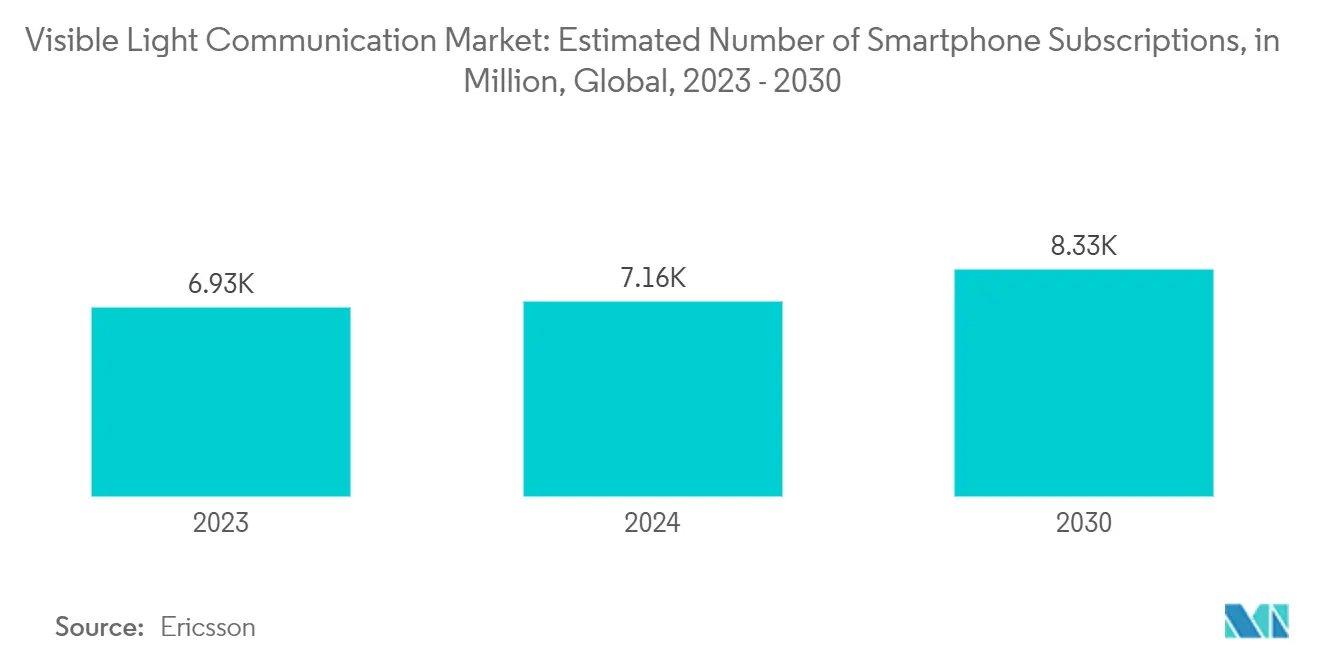
North America to Account for the Largest Market Share
- North America is set to lead the global visible light communication market, bolstered by major U.S. companies and the region's swift adoption of the technology. In the U.S., visible light communication is gaining traction as a key technology for vehicle-to-vehicle (V2V) communication, especially in enhancing autonomous vehicles. This vehicular VLC (V-VLC) utilizes vehicle headlights and taillights as wireless transmitters. As LED technology becomes more prevalent in vehicles and infrastructure, the potential for V-VLC has surged. The integration of V-VLC technology is expected to improve road safety and enhance the overall capability of autonomous driving systems, making it a critical component in the future of intelligent transportation systems.
- In North America, the growing use of indoor location-based services in hotel and retail light fixtures is expected to significantly boost regional revenues. Major players like GE Lighting and ByteLight Inc. are rolling out VLC installations in supermarkets, enabling retailers to link customers' shopping histories with their movement data. This technology not only enhances the shopping experience by providing personalized recommendations but also helps retailers optimize inventory management and store layouts based on customer behavior patterns.
- Visible Light Communication (VLC) finds diverse applications in smart homes, from smart lighting and home automation to energy monitoring and enabling battery-free duplex communication for mobile and IoT devices. GSMA projects that by 2025, IoT connections in North America will soar to 5.4 billion, encompassing both consumer and industrial sectors. The adoption of VLC in smart homes is expected to drive energy efficiency, improve connectivity, and enable seamless integration of various IoT devices, making it a cornerstone of modern smart home ecosystems.
- Moreover, with North America witnessing a pronounced digital technology penetration, the appetite for consumer electronics is on the rise, creating a fertile ground for market opportunities. For instance, the Consumer Technology Association forecasts U.S. consumer electronics retail sales to hit USD 537 billion by 2025. This growth is attributed to the growing demand for advanced technologies such as smart devices, wearables, and home automation systems, which are expected to further fuel the adoption of VLC technology in the region.
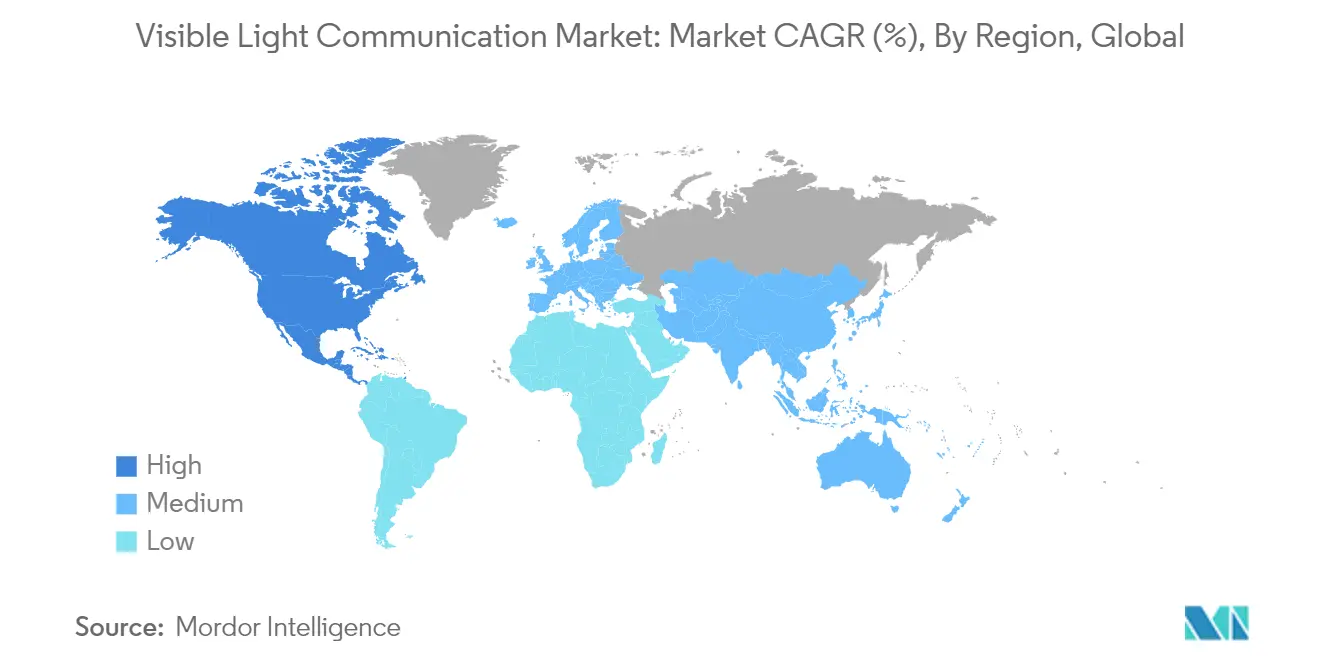
Competitive Landscape
Key players, including Koninklijke Philips, LVX System, Panasonic Corporation, and Oledcomm, dominate the Visible Light Communication Market, which sees moderate competition. These industry leaders, holding significant market shares, aim to broaden their global customer base. To achieve this, they're forming strategic partnerships and acquiring firms skilled in fixed satellite services, thus bolstering their product offerings and enhancing their technological capabilities. These collaborations and acquisitions enable them to address evolving customer needs and stay competitive in the market.
In addition, vendors are employing diverse strategies to enhance their market presence. This includes investing in research and development to refine their technical skills and create cutting-edge solutions that cater to the increasing demand for VLC technologies. With the rising adoption of these technologies across various industries, vendors are also broadening their geographical reach by entering untapped markets. This expansion strategy helps them attract more customers, increase market penetration, and drive revenue growth.
Visible Light Communication Industry Leaders
-
LVX System
-
Panasonic Corporation
-
Lucibel SA
-
Koninklijke Philips NV
-
Firefly Wireless Networks LLC
- *Disclaimer: Major Players sorted in no particular order
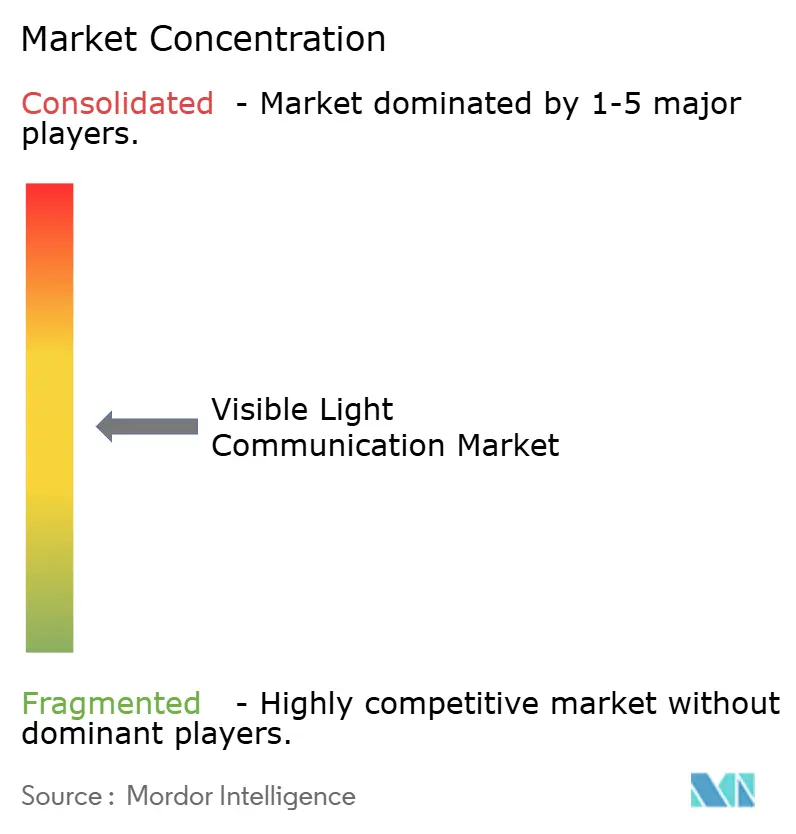
Recent Industry Developments
- March 2025: At the Mobile World Congress in Barcelona, pureLiFi, a global provider of LiFi technology, unveiled its LINXC Bridge system. In collaboration with Solace Power, this advanced solution equips Fixed Wireless Access (FWA) broadband providers with the tools to offer consumers enhanced, self-installable connectivity through outdoor Customer Premises Equipment (CPE). As a result, broadband users can look forward to swifter installations, consistent speeds, and an overall enriched experience.
- November 2024: Nav Wireless Technologies Pvt. Ltd. has inked a pivotal Transfer of Technology (ToT) agreement with the Centre for Development of Advanced Computing in Chennai. This initiative, led by the Ministry of Electronics and Information Technology (MeitY), highlights the promise of public-private partnerships in driving innovation and bolstering economic growth. The solutions, NLOS VICINITY and ILLUMINATE harness the power of Visible Light Communication (VLC) technology, catering to diverse applications from indoor positioning to smart lighting.
Global Visible Light Communication Market Report Scope
Visible Light Communication (VLC) systems aim to provide ultra-high-speed, secure, and biologically compatible networks, paving the way for the development and expansion of seamless computing applications. VLC systems harness modulated light wavelengths from various conventional sources, adapting them for communication. These sources range from outdoor and indoor lighting, illuminated signs, and displays to televisions, computer screens, and even digital cameras on mobile phones. Central to these communication systems are Light Emitting Diodes (LEDs).
The study delves deep into the trends and dynamics shaping the visible light communications landscape. Market estimates are based on tracking revenues from sales of VLC solutions by leading players. Additionally, the analysis considers demand dynamics and macroeconomic influences to refine growth trajectories and estimates.
The visible light communication (VLC) market is segmented by component (Light Emitting Diodes, photodetectors, microcontrollers, software & services), transmission type (uni-directional, bi-directional), application (consumer electronics, defense & security, transportation, public infrastructure, life sciences, and Other Applications), and geography (North America, Europe, Asia Pacific, Latin America, Middle East and Africa). The market sizes and forecasts are provided in terms of value (USD) for all the above segments.
| Light Emitting Diodes |
| Photodetectors |
| Microcontrollers |
| Software and Services |
| Uni-directional |
| Bi-directional |
| Consumer Electronics |
| Defense and Security |
| Transportation |
| Public Infrastructure |
| Life Sciences |
| Other Applications |
| North America |
| Europe |
| Asia |
| Australia and New Zealand |
| Latin America |
| Middle East and Africa |
| By Component | Light Emitting Diodes |
| Photodetectors | |
| Microcontrollers | |
| Software and Services | |
| By Transmission Type | Uni-directional |
| Bi-directional | |
| By Application | Consumer Electronics |
| Defense and Security | |
| Transportation | |
| Public Infrastructure | |
| Life Sciences | |
| Other Applications | |
| By Geography*** | North America |
| Europe | |
| Asia | |
| Australia and New Zealand | |
| Latin America | |
| Middle East and Africa |
Key Questions Answered in the Report
How big is the Visible Light Communication Market?
The Visible Light Communication Market size is expected to reach USD 4.86 billion in 2025 and grow at a CAGR of 41% to reach USD 27.11 billion by 2030.
What is the current Visible Light Communication Market size?
In 2025, the Visible Light Communication Market size is expected to reach USD 4.86 billion.
Who are the key players in Visible Light Communication Market?
LVX System, Panasonic Corporation, Lucibel SA, Koninklijke Philips NV and Firefly Wireless Networks LLC are the major companies operating in the Visible Light Communication Market.
Which is the fastest growing region in Visible Light Communication Market?
Asia-Pacific is estimated to grow at the highest CAGR over the forecast period (2025-2030).
Which region has the biggest share in Visible Light Communication Market?
In 2025, the North America accounts for the largest market share in Visible Light Communication Market.
What years does this Visible Light Communication Market cover, and what was the market size in 2024?
In 2024, the Visible Light Communication Market size was estimated at USD 2.87 billion. The report covers the Visible Light Communication Market historical market size for years: 2019, 2020, 2021, 2022, 2023 and 2024. The report also forecasts the Visible Light Communication Market size for years: 2025, 2026, 2027, 2028, 2029 and 2030.
Page last updated on:
Visible Light Communication Market Report
Statistics for the 2025 Visible Light Communication market share, size and revenue growth rate, created by Mordor Intelligence™ Industry Reports. Visible Light Communication analysis includes a market forecast outlook for 2025 to 2030 and historical overview. Get a sample of this industry analysis as a free report PDF download.
